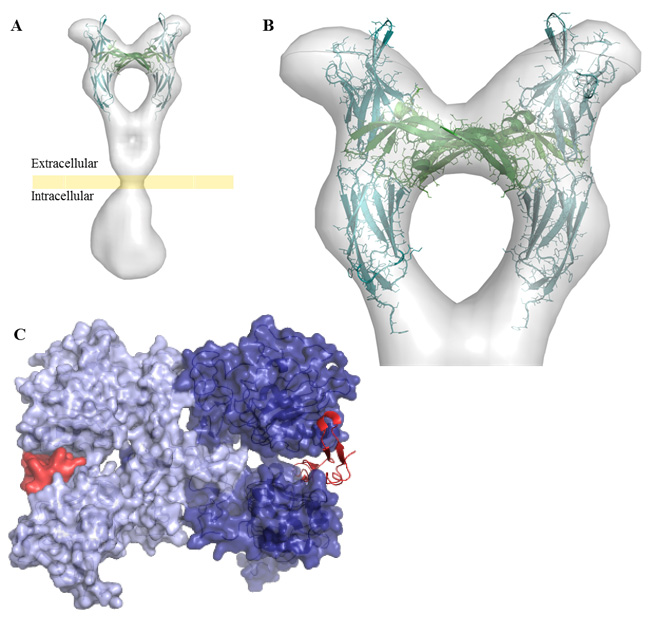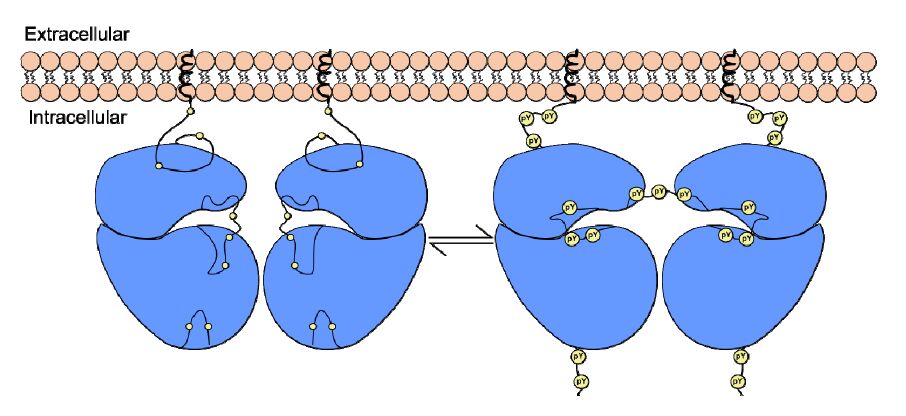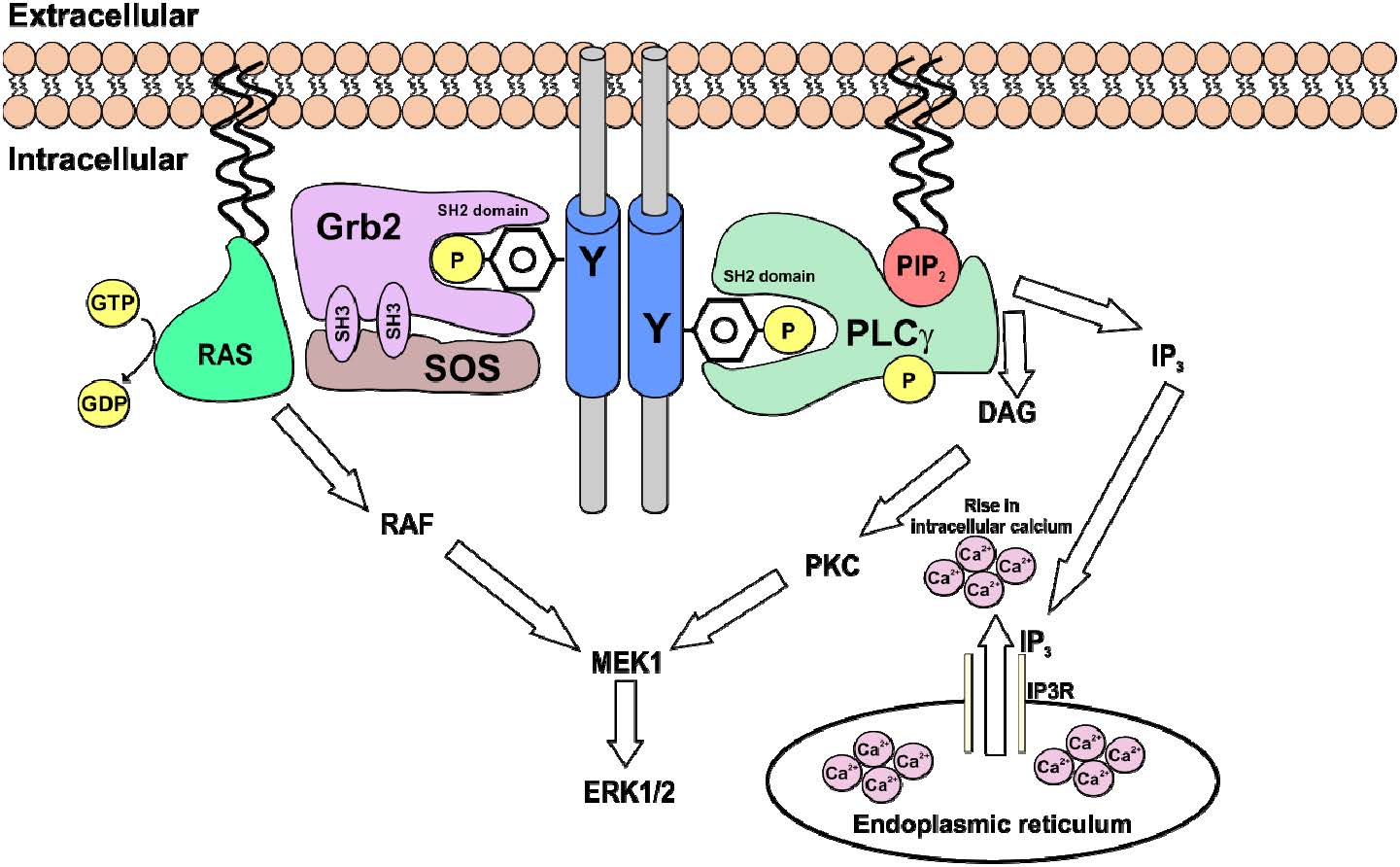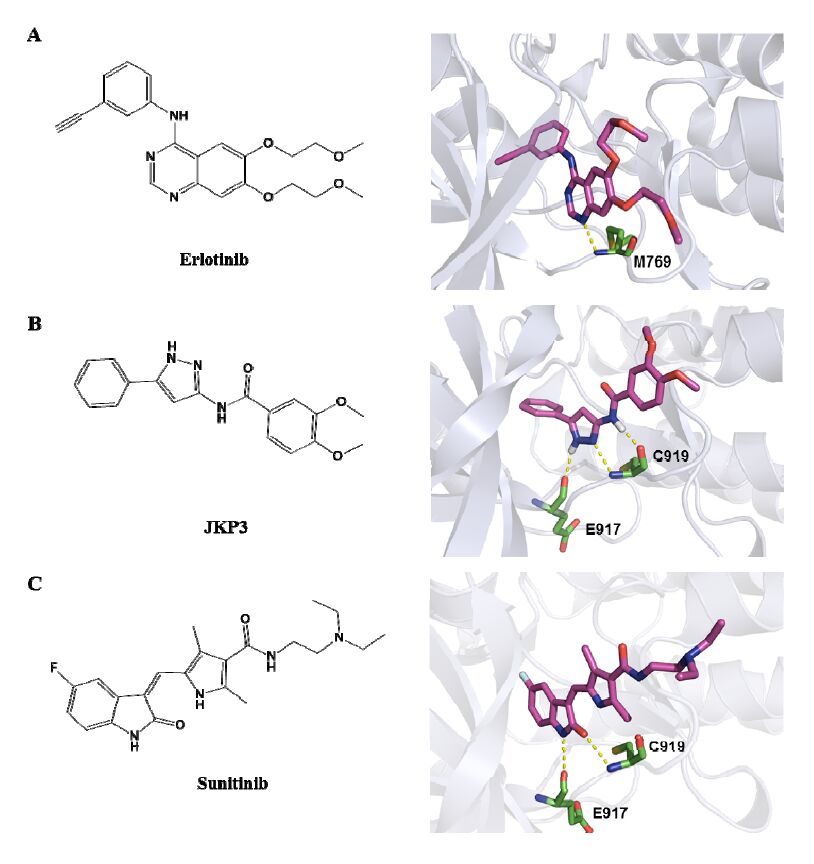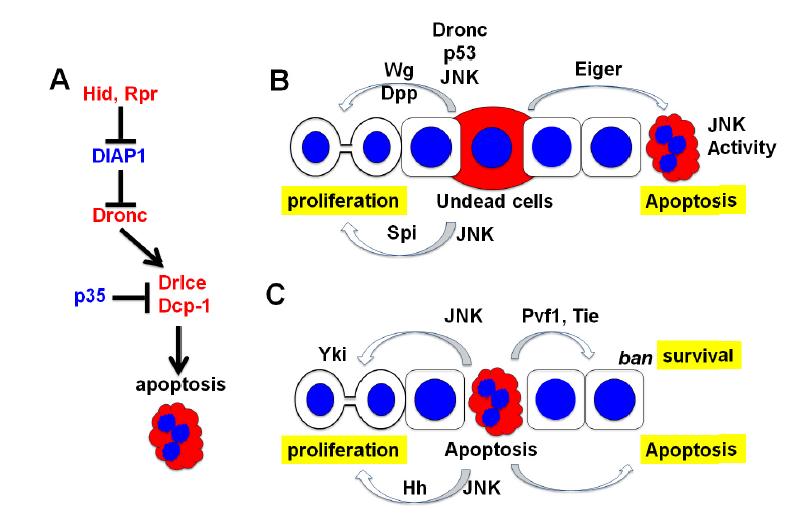1. Introduction
Receptor tyrosine kinases (RTKs) are membrane glycoproteins that regulate many cellular processes including cell migration, organ development, cell proliferation and differentiation. The human genome encodes 58 RTKs which are further divided into 20 subfamilies. The seminal study by Cohen et al. in 1965 [1] postulated that a membrane receptor was responsible for the proliferative response of epithelial cells to a soluble ligand, namely epidermal growth factor (EGF). Subsequently, in the mid-1980’s, two different groups elucidated the primary sequence of this membrane receptor that was called epidermal growth factor receptor or EGFR [2,3], triggering intensive research on these and other RTKs over the past 3 decades. This review evaluates the structural differences between distinct RTKs through assessment of specific models, as well as the implications for signal transduction, cell function and disease.
2. Structure
The majority of RTKs exhibit a similar structure (Figure 1), comprising a ligand-binding extracellular domain followed by a single transmembrane domain, juxtamembrane region, cytosolic tyrosine kinase domain (TKD), and a flexible C-terminal tail [4]. RTK extracellular domains vary between subfamilies, with different binding motifs and modules that specify ligand recognition and assembly. Through such diversity, the receptors are able to bind ligands with high specificity, thus preventing unwanted signal amplification and increasing signal precision. Extracellular regions dimerize upon ligand binding, forming higher order complexes through multiple electrostatic interactions [4,5,6]. The classical model of RTK activation consists of monomeric receptor polypeptides assembled into an active signaling homodimeric complex upon ligand interaction, with conformational changes occurring which activate the intracellular tyrosine kinase domain [7].
There are multiple forms of ligand recognition and RTK complex formation. The VEGF system is typified through ligand recognition by seven extracellular immunoglobulin-like domains, which promote VEGFR dimerization. Here, the VEGFligand exists in a dimeric state that promotes recruitment of two monomeric VEGFR-like polypeptides into a tetrameric complex. In contrast, activation of the epidermal growth factor-related RTK family (ErbB) involves a different oligomerization mechanism, whereby a single epidermal growth factor (EGF) molecule binds a single EGFR polypeptide; this interaction stimulates EGFR dimerization and the formation of an EGFR-EGF tetramer complex. Furthermore, there is evidence that EGFR may exist in an inactive but dimeric state prior to encountering EGF [8]. Based on these and other findings, a kinetic intermediate state has been proposed where the binding of one EGF molecule highly increases the affinity of this complex for a second EGF to bind [9].
The EGFR-related (ErbB) family includes EGFR (ErbB1/Her1), ErbB2 (Her2), ErbB3 (Her3), and ErbB4 (Her4), which play key roles inepithelial cell growth and proliferation [5]. The ErbB family may have evolved separately from other RTKs, since the TKD displays higher sequence similarity to Ack1, a non-receptor soluble tyrosine kinase [10]. Mouse knockouts carrying deletions in the EGFR, ErbB2, ErbB3 or ErbB4 genes all confer embryonic lethality [11]. EGFR/ErbB1 gene duplication events can give rise to gene products with impaired ligand-binding and altered TK activity [12,13].
The EGFR/ErbB1 extracellular domain is composed of ~600 residues, which mediate interactions with diverse ligands e.g. EGF, transforming growth factor α (TGFα) and betacellulin (BTC) [5]. This ectodomain consists of four distinct domains where domains I and III exhibit a β-helical fold, and domains II and IV contain cysteine-rich motifs [14]. EGF does not bind at the EGFR monomer interface with its partner, only at the ‘external’ or outward pointing surface (Figure 2C). Hence it is likely that conformational shifts within the EGFR monomer triggered by EGF binding drive monomer-monomer association and formation of a dimeric complex. Interaction interfaces are largely present within extracellular domain II on one of the monomers, wherein a rigid loop is projected onto the cysteine-rich motif, thus promoting dimer stabilization. Subsequently, the dimerizing arm from a monomer projects outwards and interacts with an adjacent EGFR monomer. As such, ligand binding creates a ~130° rotation of domains I and II with respect to domains III and IV [6]. These domains are the target of certain humanized monoclonal antibody-based therapies such as cetuximab: this antibody binds to EGFR domain III, thereby preventing ligand interaction and active state conformation [15]. In this context, matrix metalloproteinases (MMPs) can cleave the extracellular EGFR domains, leaving the kinase and juxtamembrane domains intact and a constitutively active TKD [16,17]. The ErbB extracellular domains are heavily glycosylated, with EGFR/ErbB1 alone displaying ~40 kDa of complex carbohydrates; N-glycosylation is critical for EGFR/ErbB1 maturation and export to the c
ell surface [18,19]. Interestingly, ErbB homo- and heterodimerization along with overexpression are frequently linked to epithelial cancer initiation and progression.
The vascular endothelial growth factors (VEGFs) bind to VEGFR family members [20]. VEGFR gene products include both soluble and membrane-bound isoforms which regulate many aspects of vascular physiology including angiogenesis and lymphangiogenesis. Mammalian VEGFR2 has seven immunoglobulin (Ig)-like domains in the extracellular region, a short transmembrane region, a juxtamembrane domain, and a split tyrosine kinase domain (Figure 1) [21]. Biosynthetic immature VEGFR2 transits the ER and Golgi compartments, undergoing N-linked glycosylation to produce a ~230 kDa polypeptide [22,23]. This mature, glycosylated VEGFR2 is then displayed on the cell surface where binding to VEGF-related ligands activates signal transduction [24].
VEGF-A binding to Ig-like domains 2 and 3 on the VEGFR2 ectodomain [25] mediates RTK dimerization. This is an example of a fully “ligand-dependent” receptor dimerization mechanism as modeled in Figure 2A-B. The VEGFR2-VEGF-A complex is further stabilized by low-affinity homotypic interactions between Ig-like domain 7 [26]. Interestingly, deletion of Ig-like domains 4-7 causes ~1000-fold decrease in VEGFR2 affinity for VEGF-A [25] suggesting complexity in this RTK-ligand interaction for maximal ligand binding and TKD activation. VEGF-A-mediated dimerization of the VEGFR2 ectodomains causes positioning and contact alignment of adjacent TKDs in the cytoplasm, resulting in torsional rotation and exposure of an ATP-binding site. In another closely related RTK subfamily, the c-KIT receptor binds to stem cell factor (SCF) via Ig-like domains 1, 2, and 3, causing RTK dimerization and creating critical interactional interfaces through conformational changes. A similar mechanism has been proposed for another closely related RTK subfamily containing the platelet-derived growth factor receptors (PDGFRs): in PDGFR-β, a mutation within such interacting interfaces impairs downstream RTK activation and signal transduction [27,28].
The insulin-like growth factor receptor subfamily includes the insulin receptor (INSR) and defines a conserved set of genes found in many higher eukaryotes [29]. This subfamily is unique in that the RTK is displayed as a pre-assembleddisulfide-linked heterotetramer: the α2β2 complex is derived from a single polypeptide that undergoes post-translational cleavage to generate a soluble extracellular α domain, which is linked by a disulfide bond to the membrane-spanning β polypeptide [30,31] (Figure 1). Cells that express both INSR and IGF1R gene products can express mixed or hybrid tetramers. Interestingly, these hybrid RTKs display high affinity for IGF-1 but low affinity for insulin [32].
Monitoring insulin binding to INSR suggests the existence of multiple high and low affinity binding sites. Each INSRα subunit contains two distinct low affinity sites for insulin. Ligand binding to one low affinity binding site on INSR, promotes a second ligand molecule to bind to the other low affinity site on the adjacent INSRα subunit. However, this is a model of allosteric inhibition where initial ligand binding to each INSRα subunitinhibits further binding to the second binding site on the same subunit [31]. Furthermore, the subfamily of discoidin domain receptors (DDR1, DDR2) that bind collagen can exhibit similar pre-assembled oligomeric states, albeit via non-covalent interactions between different polypeptide chains [33].
The presence of complex carbohydrates can frequently modulate the nature of RTK-ligand interactions and signal transduction. The fibroblastgrowth factor receptor (FGFR) subfamily requires the presence of heparan sulphate proteoglycans (HSPGs) as co-factors for maximal FGF-mediated signal transduction and cellular responses. An impaired HSPG biosynthesis pathway can have adverse effects on FGFR function during development [34]. Although controversial, a consensus view is that a FGF-FGFR-HSPG complex with a 2:2:1 stoichiometry is needed for maximal TKD activation [35]. Furthermore, it has been implied that HSPGs can also act as VEGFR co-receptors to modulate VEGF-A-stimulated signal transduction and endothelial responses [36].
3. RTK Activation and Signal Transduction
3.1. Auto-inhibition
In the resting or basal state, each RTK still displays residual or basal enzymatic kinase activity. The resting RTK complex is postulated to ‘breathe’ or fluctuate between dynamic states; even in the absence of ligand, soluble tyrosine kinases (e.g. c-Src) could phosphorylate the TKD and thus trigger basal signal transduction [4]. To prevent spontaneous trans-autophosphorylation, RTKs contain a number of auto-inhibitory elements, with most TKDs inhibited in a unique way [37]. Phosphorylation sites that promote TKD activation are present within the juxtamembrane domain, activation loop and C-terminal tail of RTKs. The activation loop resides within the active site of the TKD thus sterically hindering access by ATP to the nucleotide-binding pocket. Phosphorylation of the activation loop promotes conformational changes, inducing swinging out of the activation loop which releases auto-inhibition effects as well as stabilizing the activated TKD [37]. In the resting RTK state, the juxtamembrane domain and C-terminal tail both make contacts with the TKD to prevent activation; nonetheless, basal kinase activity may still be present [38].
3.2. Activation
Ligand-stimulated RTK dimerization stimulates trans-autophosphorylation of auto-inhibitory elements, promoting a conformational change within the TKD that opens the nucleotide and substrate-binding sites (Figure 3). The cytoplasmic TKD can be divided into an N-lobe and a C-lobe with the active ATP-binding site in the center (Figure 3). RTK activation requires trans-autophosphorylation on specific tyrosine residues: such events can dramatically reduce auto-inhibitory effects and stimulate the active site to hydrolyze ATP and transfer g-phosphate onto the hydroxyl group within the tyrosine side chain. The phosphorylated tyrosine side chains subsequently act as recruitment sites for adaptors and enzymes containing Src homology 2 (SH2) or phosphotyrosine-binding (PTB) domains. INSR was the first RTK exemplifying cis-auto-inhibition, where cytoplasmic Y1162 residue occludes the ATP-binding site within the inactive TKD. INSR activation of the adjacent b subunit promotes dissociation of this inhibitory loop, thus promoting a ‘relaxed state’ with an ‘open’ nucleotide-binding site that can now bind ATP [38]. EGFR/ErbB1 is unique in that it does not require trans-autophosphorylation for dimerization and removal of intramolecular inhibition: the activator C-lobe of one EGFR/ErbB1 monomer physically interacts with a receiver N-lobe on a second EGFR/ErbB1. In this way, a conformational change is implemented, promoting active site opening of the receiver TKD through the activation loop swinging out [9]. RTKs may be activated through varying mechanisms but the activated signal transduction complexes share many common features [39].
There are additional inhibitory elements present within the juxtamembrane domain. The juxtamembrane sequence protrudes outwards and interacts with the TKD and activation loop, further occluding the binding site for ATP [38]. Upon tyrosine phosphorylation, this loop swings away from the TKD, thus opening access to the kinase active site; juxtamembrane auto-inhibition has been identified in Eph receptors, KIT, MuSK, and Flt3 [40,41,42,43]. Notably, naturally occurring mutations within the juxtamembrane domain have been identified in constitutively active c-KIT and PDGFR gene products associated with certain cancers [44]. Peculiarly, the EGFR/ErbB1 juxtamembrane domain contains activating rather than inhibitory properties. T654 and T669 residues within the EGFR/ErbB1 juxtamembrane domain undergo phosphorylation and are implicated in RTK trafficking [45,46,47]. Mutation of the carboxy-proximal portion of this juxtamembrane region causes loss of TK activity likely due to disruption of the EGFR/ErbB1 unique donor/acceptor lobe conformation. Furthermore, 19 residues within this juxtamembrane domain are postulated to be part of an activation motif that interacts with the C-lobe of the donor TKD; such interactions are necessary to spatially align the activator C-lobe for maximal activity [48]. In this context, certain mutations in EGFR/ErbB1can promote activating stability of juxtamembrane domain interactions, thereby negating inhibitory effects that promote lung cancer development [49].
Trans-autophosphorylation events appear to occur in a specific order, where the sequence of events specifies marked conformational changes and intermolecular interactions within the RTK complex. In IGF1R, the initial tyrosine phosphorylation event leads to an increased Vmax in TK activity due to destabilization of inhibitory effects. Each tyrosine autophosphorylation event in IGF1R increases enzyme turnover number and reduces the Km for ATP and specific peptide substrate binding [50].
Within the VEGFR complex, dimerization induces conformational changes which promote the TKD to move into an ‘open state’, which favors catalytic activity. This conformation enables ADP/ATP exchange at the nucleotide-binding site and subsequent transfer of the ATP g-phosphate onto specific cytoplasmic tyrosine side chains e.g. Y801, Y951, Y996, Y1054, Y1059, Y1175, Y1214 [51,52]. Notably, Y801 lies within the VEGFR2 juxtamembrane region, indicating that phosphorylation removes auto-inhibitory effects contributed by this loop to the TKD. The role of VEGF-A isoform diversity in eliciting different cellular responses is highlighted by the finding that binding of anti-angiogenic VEGF-A165b splice isoform to VEGFR2 causes insufficient torsional rotation of the complex, resulting in rapid closure of the nucleotide-binding site and reduced TK activity [53,54]. Similar to the ErbB family, Ret subfamily members do not require trans-autophosphorylation for activation; instead they contain allosteric mechanisms and specific intracellular domains responsible for mediating receptor activation [55,56].
3.3. RTK Signal Transduction
A recurring theme in RTK activation and communication into the cell interior is generation of phosphorylated cytoplasmic domain tyrosine residues that serve as communication nodes in the signal transduction process. The binding of proteins containing SH2 or PTB domains is a critical feature in the propagation of signals along different pathways that modulate cellular function [57,58]. A unique example are adaptor molecules such as fibroblast growth factor receptor substrates i.e. FRS family members such as FRS2α and FRS2β, which contain PTB domains that enable binding to different phosphotyrosine residues within FGFR juxtamembrane regions to facilitate signal transduction. In contrast, FGFR1 activation and Y766 phosphorylation within the C-terminal tail enables PLCγ1 recruitment [59].
In general, proteins and lipids involved in signal propagation are spatially configured to facilitate effective signal transduction. For instance, in the case of PLCγ1, two different SH2 domains enable phosphotyrosine recognition within the RTK complex; the C2 domain facilitates calcium-dependent binding to the phospholipid bilayer. The pleckstrin homology (PH) domains bind to phosphoinositides such as PtdIns(4, 5)P2, which enables the catalytic domain to hydrolyze this membrane-bound lipid to Ins(1, 4, 5)P3 and diacylglycerol (DAG). These latter molecules are small diffusible substances that act as second messengers to further propagate signal transduction and modulate cell function. Therefore, in PLCγ1 recruitment and activation, multivalent and cooperative binding effects must be integrated with spatial orientation of these different binding sites and be preserved for optimal signal transduction [57,60,61,62]. Interaction of SH2 or PTB modules with activated RTKs promotes conformational changes within both the RTK and recruited adaptor/enzyme; moreover, such molecular communications promote specific interactions with other downstream factors in signal transduction pathways [63].
3.4. The SH2 domain
Binding specificity of the SH2 domain partially depends on residues at positions +1 and +3 around the central phosphotyrosine in the binding motif [64,65]. PLCγ1 interaction with activated RTK is mediated via two SH2 domains (N-SH2 and C-SH2) [66]. Binding affinity and phosphotyrosine selectivity of the two SH2 domains within PLCγ1 are highly similar when interacting with activated EGFR (Figure 4) [67]. It was discovered that the N-SH2 domain binds to the C-lobe within FGFR1 with relatively high affinity (Kd ~30 nM) independent of tyrosine phosphorylation. PLCγ1 recruitment was compromised when the residues within the FGFR1 C-lobe were mutated [68]. However, it has been suggested that N-SH2 interaction with this novel binding site is responsible for target specificity, whilst the classical SH2:phosphotyrosine interaction is responsible for temporal specificity [68].
3.5. Signal Transduction Complexity
RTKs can contain 5-12 sites for tyrosine phosphorylation that vary depending on the ligand, RTK and cellular context. Each phosphotyrosine site thus has a potentially unique capability in recruiting signaling proteins containing SH2 or PTB domains. Considering that each signaling adaptor or enzyme is able to interact with multiple downstream factors, there is an exponential increase in the strength and complexity of various signals [4,58]. Such pathways can incorporate positive and negative feedback loops to modulate length and duration of the signal [69]. Systems biology has postulated that several key RTK signal transduction regulators are present centrally in the overall signaling cascade, being part of an “hourglass model”. A few select RTK cytosolic regulators, largely kinases, are responsible for deciphering incoming signals associated with RTK activation, and the interpretation of such signals triggers diverse outputs that shape the cellular response [70]. Central processing influences critical feedback mechanisms in the form of kinase-dependent phosphorylation/dephosphorylation, ubiquitination, trafficking and GTPase communication [71].
Protein tyrosine phosphatase (PTP) activity controls activated RTK status and signal duration by dephosphorylating activated phosphotyrosines on RTKs [72]. Another example of a feedback mechanism is the generation of reactive oxygen species (ROS). EGFR/ErbB1 activation can trigger hydrogen peroxide production leading to elevated ROS levels as a byproduct of PtdIns3K recruitment and activation at the plasma membrane. ROS inhibit PTP activity; however, ROS have a short half-life so effects on PTP activity (and thus RTK status) are relatively short-lived [73]. ROS-mediated inhibition of MAPK activity occurs through direct modulation of Sos and Raf activity, thus limiting availability for participation in signal transduction [74].
3.6. Trafficking
RTKs undergo co-translational insertion into the endoplasmic reticulum and transport through the Golgi apparatus prior to reaching the plasma membrane. Most RTKs are largely localized to distal compartments (i.e. plasma membrane, endosomes). However, some RTKs such as VEGFR1 and VEGFR2 display significant association with the Golgi apparatus under steady-state conditions [75].
It is relatively well-known that many RTKs undergo internalization at the plasma membrane: both clathrin-dependent (CDE) and clathrin-independent (CIE) endocytosis pathways have been implicated [76]. It is still unclear how resting or activated RTKs are selected as cargo for inclusion into such routes; this is complicated by the relatively large cytoplasmic domains and motifs (500-1000 residues) present within each RTK. EGFR/ErbB1 [77], FGFR1 [78] and VEGFR2 [79] undergo CDE; however, CIE has been implicated in EGFR/ErbB1 [80] and VEGFR2 [79,81,82] internalization. The RTK-ligand complexes are likely to undergo dissociation within the low pH environment of the endosome lumen [4], thus facilitating growth factor release for subsequent lysosomal degradation. Furthermore, the endosome-associated unoccupied RTK can follow various routes including lysosomal degradation or recycling back to the plasma membrane [83].
RTK ubiquitination is an important feature of activation, trafficking and down-regulation. The temporal sequence of EGFR/ErbB1 and VEGFR2 ubiquitination suggests that RTK activation recruits ubiquitination enzymes such as the c-Cbl or b-TrcP E3 ligases [81,84,85]. It is unclear as to whether RTK ubiquitination occurs at the plasmamembrane or endosomal stages. Other studies suggest the participation of a complex web of heat-shock proteins (HSPs), 26S proteasome and ubiquitin-linked enzymes in RTK signal transduction, trafficking and proteolysis [86,87,88,89,90].
Neurotrophin RTKs such as TrkA and TrkB expressed on sensory neurons bind to ligands such as NGF or BDGF and undergo endocytosis and unique signal transduction outcomes. In TrkA, a unique motif within the juxtamembrane domainregulates plasma membrane recycling whereas TrkB complexes are predominantly targeted for proteolysis after activation [91,92,93]. Interestingly, introduction of the TrkA recycling motif into the TrkB juxtamembrane region caused preferential plasma membrane recycling rather than degradation [93]. The Eph subfamily also regulates many key decisions in development of the neural network. Eph interactions with cognate ligands such as membrane-associated ephrins present on target cells regulate bidirectional internalization of the Eph-ephrin complex, thereby modulating cytoskeletal dynamics and cell-cell contacts [94]. Specific ephrin: Eph ectodomain cleavage preceding Rho GTPase activation modulates cell adhesion and migration in neurons [95].
It has additionally been proposed that EGFR/ErbB1, ErbB4 or proteolytic fragments are present within the nucleus, regulating gene expression and other activities [96,97,98,99]. Nuclear localization of tyrosine kinase receptors was first identified in primary adrenocortical carcinomas and regenerating hepatocytes [100,101]. Members of the EGFR, FGFR, and VEGFR familieslocalize to the nucleus in their phosphorylated forms in a number of cancer cell lines; higher nuclear expression levels of EGFR correlate with a worse patient outcome [102,103,104]. Although EGFR contains no nuclear localization motifs, it is able to interact with a number of cancer-promoting gene products, and has been co-localized in the nucleus in patients undergoing ionizing radiation or cisplatin cancer therapies [103]. Wang et al. proposed a mechanism of retroactive EGFR transport to the nucleus following RTK activation and CDE [105]. Retrograde transport via endocytic vesicles returns EGFR to the Golgi rather than the ER via a COPI-dependent pathway [105]. ErbB family members are postulated to contain an arginine-rich nuclear localization signal within the juxtamembrane region tripartite sequence (residues 645-657), which requires initial interaction with α1 and β1 integrins prior to nuclear import [47]. Nuclear export of EGFR/ErbB1 has been suggested to involve CRM1, involved in facilitating nuclear-cytoplasmic translocation [102].
4. RTK Role in Disease
4.1. Tumorigenesis
A number of distinct mutations in RTK-encoding genes are linked to various types of cancer. These are documented within the list of known cancer-linked alleles in a database called the Catalogue of Somatic Mutations in Cancer (COSMIC) and in Table 1 [106]. Gain-of-function mutations within RTK ectodomains cause increased RTK dimer stabilization, activation and signaling in the absence of ligand [4,107]. Other RTK allelic polymorphisms in the juxtamembrane and kinase domains cause oncogenic transformation by promoting a constitutive signaling state and impairing auto-inhibitory regulation, as seen from studies on gastrointestinal stromal tumors (GISTs) (Table 1) [108]. RTK gene polymorphisms within exons encoding the ligand-binding, transmembrane, juxtamembrane, TKD, activation loop and C-terminal tail are also linked to haematological and solid tumor malignancies (Table 1) [27].
Table 1. Genetic mutations in RTKs and disease links.
| GENE | COMMON MUTATIONS | MAIN TISSUES | TYPE OF MUTATION |
| ALK | R1275Q | Autonomic ganglia, large intestine, breast | Missense substitution |
| F1174L | Autonomic ganglia | Missense substitution |
| H1030P | Upper aerodigestive tract, thyroid | Missense substitution |
| CSF1R | Y969C | Haematopoietic & lymphoid | Missense substitution |
| E705fs*22 | Kidney | Deletion, frameshift |
| EGFR | L858R | Lung | Missense substitution |
| E746_A750 | Lung | Deletion, in frame |
| T790M | Lung | Missense substitution |
| G598V, A289V, R108K, A289T | CNS | Missense substitution |
| L861Q | Lung, skin, oesophagus | Missense substitution |
| ERBB2/HER2 | A775_G776insYUMA | Lung, ovary, breast | Insertion, in-frame |
| L755S | Breast, small intestine, stomach, large intestine, endometrium | Missense substitution |
| S310F | Urinary tract, stomach, lung, large intestine, breast | Missense substitution |
| R678Q | Stomach, large intestine, urinary tract, enodmetrium, pancreas | Missense substitution |
| V842I | Large intestine, stomach, endometrium, biliary tract, breast | Missense substitution |
| V777L | Large intestine, stomach, breast, lung | Missense substitution |
| FGFR1 | N546K | CNS, soft tissue, autonomic ganglia | Missense substitution |
| K656E | CNS, haematopoietic & lymphoid | Missense substitution |
| T141A | Large intestine | Missense substitution |
| FGFR2 | S252W | Endometrium | Missense substitution |
| N549K | Endometrium, breast, lung | Missense substitution |
| C382R | Endometrium, biliary tract, large intestine, oesophagus, stomach | Missense substitution |
| Y375C | Endometrium, biliary tract, salivary glan, liver | Missense substitution |
| K659E | Endometrium, ovary, CNS | Missense substitution |
| N549K | Endometrium, urinary tract, upper aerodigestive tract, breast | Missense substitution |
| FGFR3 | S249C, G370C | Urinary tract, skin | Missense substitution |
| Y373C, R248C | Urinary tract, skin, haematopoietic & lymphoid | Missense substitution |
| FGFR4 | N495K | Soft tissue, large intestine | Missense substitution |
| FLT3 | Unknown insertion | Haematopoietic & lymphoid | Insertion, in frame |
| D835Y, D835V | Haematopoietic & lymphoid | Missense substitution |
| KIT | D816V | Haematopoietic & lymphoid, skin, testes, ovary | Missense substitution |
| W557_K558del | Soft tissue | Deletion, in-frame |
| V559D | Soft tissue, skin | Missense substitution |
| MET | Y1253D | Upper aerodigestive tract | Missense substitution |
| T1010I | Lung, thyroid, kidney, large intestine, bone | Missense substitution |
| M1268T | Kidney, large intestine | Missense substitution |
| Y1248C | Upper aerodigestive tract, large intestine, kidney | Missense substitution |
| NTRK1 | R649W | Liver, ovary | Missense substitution |
| A107V | Lung, large intestine, ovary | Missense substitution |
| Q80* | Lung, large intestine | Nonsense substitution |
| NTRK3 | K732T | Stomach, upper aerodigestive tract, oesophagus, pancreas, large intestine | Missense substitution |
| PDGFRα | D842V | Soft tissue, stomach, large intestine, small intestine | Missense substitution |
| S566_E571>R | Soft tissue, stomach, small intestine | Complex, deletion in-frame |
| V561D | Soft tissue, stomach | Missense substitution |
| PDGFRβ | R853W | Pancreas, large intestine | Missense substitution |
| T369M | Large intestine | Missense substitution |
| R251H | Urinary tract, large intestine | Missense substitution |
| Y589H | Stomach | Missense substitution |
| S650L | CNS | Missense substitution |
| RET | M918T | Thyroid, adrenal gland, breast | Missense substitution |
| C634R, C634Y | Thyroid | Missense substitution |
| E632_T636>SS | Thyroid | Complex, deletion in-frame |
| ROS | E1642K, P1108S | Skin | Missense substitution |
| R245I | Endometrium | Missense substitution |
| E527K | Skin, large intestine | Missense substitution |
| VEGFR2/KDR | Q472H | Large intestine, haematopoietic & lymphoid, stomach | Missense substitution |
| R1032Q | Skin, large intestine | Missense substitution |
| R1032* | Haematopoietic & lymphoid, large intestine, prostate, CNS | Nonsense substitution |
| Compilation of disease mutations in different RTKs and linkage to human disease phenotypes. Many of these details were obtained from the COSMIC database (http://cancer.sanger.ac.uk/cosmic). |
Pathological angiogenesis is a hallmark of cancer, and as like all tissues, tumors require a healthy blood supply for providing nutrients and oxygen, as well as allowing the removal of metabolic wastes and carbon dioxide [109]. In order for a solid tumor to grow beyond 1-2 mm in diameter, it must recruit surrounding vasculature via stimulation of angigoenesis [110]. One way in which tumors promote angiogenesis is by increasing VEGF-A expression through hypoxia-induced HIF-1-dependent VEGFA gene transcription. Dysfunctional VEGFR2-VEGF-A signaling is linked to multiple disease pathologies such as tumor development and metatasis, atherosclerosis, ischemia, diabetes and age-related macular degeneration (AMD). Increased VEGFR2 and VEGF-A expression is implicated in multiple cancers including bladder, brain, breast, colon, gastric, lung, and prostate [111]. Interestingly, autocrine VEGF-A-stimulated signal trasduction has also been attributed to tumor progression [112,113]. Autocrine VEGF-A signaling via PtdIns3K-Akt and MEK1-ERK1/2 signal transduction pathways in tumors is implicated in promoting cell growth, migration, survival and invasion [111].
Hypoxic tumor cells primarily rely on glucose as a carbon source for rapidly generating ATP [114]. Oxygenated tumor cells can also use glucose (aerobic glycolysis), a phenomenon called the Warburg effect [115]. Both metabolic processes generate lactate as a byproduct. High levels of lactate can stimulate angiogenesis by promotingligand-independent activation of VEGFR2 and the PtdIns3K-Akt pathway [114]. This effect is dependent on three different RTKs working in concert: VEGFR2, Axl and Tie2 [114]. Moreover, lactate enters endothelial cells via the MCT1 transporter and inhibits the oxygen-sensing prolyl hydoxylase 2 enzyme (PHD2), thus stabilizing hypoxia-inducible factor 1α (HIF-1α); increased VEGFA gene transcription thereby further stimulates angiogenesis[116,117]. Under conditions of wound healing and tissue ischemia, a combination of reduced vascular perfusion and increased oxygen consumption leads to hypoxia [114,118,119]. This causes a metabolic switch favouring glycolysis and increased lactate production [114,119]. Elevated lactate levels stimulate angiogenesis as a means of promoting blood vessel growth to combat tissue ischemia and injury by previously described mechanisms.
ErbB polymorphisms show a strong correlation with the incidence of malignant tumors (Table 1) [120]. Overexpression of the ErbB receptor family within neoplastic tissues is associated with poor patient prognosis [121,122]. Overexpression of EGFR/ErbB1 ligands such as EGF and TNFα within neoplastic tissues increases autocrine signal transduction and cell proliferation [123]. EGFR/ErbB1 signal transduction is characterized by positive feedback loops which have been the focus of monoclonal antibody therapy for such cancers [124]. EGFR polymorphisms within exons 18-24 that encode the TKD are associated with increased TK activity and signal transduction (Table 1) [125]. Interestingly, Sharma et al. point out the controversy surrounding the predictive value of EGFR mutations in non-selected patient groups where 10-20% of patients who show a partial response to the small molecule EGFR inhibitor gefitinib do not have an identifiable EGFR/ErbB1 mutation [126]. Thus EGFR/ErbB1 polymorphisms may not be solely responsible for the inhibitory effect caused by RTK-specific drugs [126,127,128].
4.2. Atherosclerosis and Diabetes
Hypercholesterolemia is associated with atherosclerosis, as well as being an underlying condition in ischemic vascular disease [129]. During periods of hypercholesterolemia, both vascular function and de novo blood vessel formation is impaired [129,130,131]. One reason is that increased low-density lipoprotein (LDL) levels attenuate VEGF-A-stimulated signal transduction [129]. Endothelial cell exposure to LDL depletes VEGFR2 from the cell surface by promoting VEGFR2 turnover via a syntaxin-16-dependent mechanism [129]. Reduced VEGFR2 levels are responsible for the decrease in VEGF-A-stimulated Akt and ERK1/2 signal transduction, which impairs endothelial cell proliferation, migration and tubulogenesis [129].
Diabetes patients suffer from multiple vascular problems and poor wound healing due to endothelial dysfunction [132]. Chronic diabetes creates a paradox whereby both accelerated and poor angiogenesis states exist in the same tissue [133,134]. Diabetes-linked hyperglycaemia can cause activation of protein kinase C-dependent pathways and other factors that stimulate ROS production [132]. Elevated ROS levels lead to ligand-independent VEGFR2 activation, depletion of plasma membrane levels and reduced VEGF-A-stimulated signal transduction [135].
4.3. Other disease states
Members of the FGFR family are strongly linked to boneabnormalities and developmental disorders. FGFR1-deficient mice display embryonic lethality with defects in mesoderm differentiation [136,137]. Furthermore, gain-of-function FGFR1 polymorphisms have been identified in osteoglophonic dysplasia, where such patients exhibit short-limbed dwarfism (Table 1); FGFR3 transmembrane mutations can induce achondroplasia (Table 1) [138,139]. The P252R polymorphism in FGFR1 causes Pfeiffer syndrome, characterized by premature fusion of certain bones of the skull. FGFR1-deficient adult mice show increased bone mass suggesting an important role in regulating bone density during development [140]. FGFR1 may regulate the differentiation of mesenchymal progenitors into pre-osteoblasts. However, FGFR1 simultaneously inhibits mesenchymal progenitor cell proliferation in addition to regulating osteoblast maturation and mineralization [140,141].
5. Small Molecule-based Targeting of RTK Function
Small molecule inhibitors are widely used therapeutics that can target RTK functionality in disease states such as cancer. A major advantage of this approach is unique intellectual property and patentability, lower industrial production costs and decreased potential immunogenicity. In most cases, RTK small molecule inhibitors are membrane-permeable organic molecules that diffuse across the membrane bilayer and target the TKD nucleotide-binding site, either through allosteric or competitive modes of inhibitory action. However, accumulating evidence from different tyrosine kinase inhibitors (TKIs) in complex with different TKDs suggest structural similarities, implying decreased drug specificity and significant multi-kinase inhibition [142]. An example of select small molecule inhibitors can be seen in Figure 5. In addition to small molecule inhibitors, inhibition therapy utilizing monoclonal antibodies is of equal importance, and has proven to be highly effective. However, their use and mechanism of action is beyond the scope of this review, and has been adequately summarized in the following articles [143,144].
5.1. VEGFR Inhibitors
VEGF-A is essential for human vascular homeostasis, growth and development [145]. However, VEGF-A-regulated angiogenesis is associated with diseases characterized by abnormal neovascularization including cancer, proliferativeretinopathy and age-related macular degeneration [145,146]. To combat these diseases, anti-VEGF-A humanized antibodies and small molecule TKIs have been developed as drugs for both local and systemic application. Therapeutics which inhibit angiogenesis by targeting VEGF-A (e.g. bevacizumab) have assisted in the treatment of several tumors [147]. Small molecule TKIs are increasingly produced through in silico modeling of drug design in conjecture with the binding site. One such example is the identification of a novel pyrazole-based scaffold produced through de novo structure-guided design (JK-P3; Figure 5B) for inhibition of VEGF-A-stimulated cell migration, proliferation, and angiogenesis [148]. The anti-cancer drug sunitinib (Sutent) is a member of the indolinone family of compounds and has been clinically approved for renal cell carcinoma (RCC) and gastrointestinal tumors (GIST) [147]. A major drawback is lack of specificity due to a multi-kinase inhibitory profile, which additionally targets other RTKs including c-KIT, PDGFR, Flt-3, and RET [149]. A further worry is that meta-analyses on clinical trials of sunitinib and bevacizumab have correlated with increased risk of congestive heart failure [150].
Other successful VEGF-related therapies which provide greatest improvement in progression-free survival in cancer patients include sorafenib [151]. Sorafenib is used to treat hepatocellular carcinoma and advanced RCC. Many small molecules designed to inhibit VEGFR2, such as sunitinib and sorafenib, are non-specific and inhibit other RTKs including PDGFR and c-KIT [152,153]. Dual FGFR-VEGFR tyrosine kinase inhibitors under development include Vargatef and brivanib [154]. Although providing short-term benefits, activity of such drugs is limited by the appearance of compensatory pathways or resistance mechanisms in tumors within 6-24 months [153,155]. Thus targeting RTKs in a selective manner is important for a cancer-free state [153,155].
Despite the relatively large number of TKIs that target VEGFR2 activity, certain structural features are conserved. Residues E917 and C919 within the VEGFR2 TKD are important for inhibitor binding through hydrogen donor and acceptor bonds (Figure 5B and 5C) [156,157,158]. Other residues involved in inhibitor binding to VEGFR2 include E883, K868 and N923 for pyrimidine analogues and D1046 for anilinophthalazines [156,157,158]. An Asp-Phe-Gly (DFG) motif in the kinase domain activation loop is also involved in the binding of multiple inhibitors [158,159]. Interestingly, pyrazole-based scaffold JK-P3 (Figure 5B) exhibits greater inhibition of VEGFR2 then FGFR1, a characteristic only observed for more selective VEGFR inhibitors such as anilinophthalazine PTK787 [158]. Notably, JK-P3 inhibits VEGF-A-dependent VEGFR2 activation and downstream signal transduction, but does not inhibit signaling in response to other ligands such as EGF, bFGF and IGF-1 [160]. Emerging TKIs that selectively inhibit VEGFR2 activity and signal transduction include ramucirumab, a fully humanized monoclonal antibody targeting the extracellular domain and apatinib, a small molecule inhibitor that binds the TKD [147].
5.2. ErbB Inhibitors
EGFR/ErbB1 is the most prominent signal transducer of the ErbB family, however ErbB2 has been found to have influential roles in disease states. Overexpression of ErbB2 (HER2) is correlated with dysregulated EGFR/ErbB1 signaling; ErbB2 overexpression has been observed in a number of breast cancers [161]. A small molecule kinase inhibitor termed lapatinib has been approved by the FDA for preventing ErbB2 activation. However, accounts have risen stating unprecedented developed resistance to lapatinib through alteration of apoptotic pathways [162,163].
Furthermore, EGFRs contain a critical role in non-small lung cell carcinomas (NSCLCs), the malady representing the leading cause of cancer-related deaths [164]. EGFRs are present in 90% of squamous cell NSCLCs, and in 30-65% of adenocarcinoma subtypes of NSCLCs [165,166]. Two drugs, gefitinib and erlotinib (Figure 5A), were developed as reversible competitive inhibitors of the EGFR/ErbB1 TKD, exhibiting structural similarity to ATP (mimetic) and approved by the FDA in 2003 for clinical use [167].
Due to controversy, studies had to be carried out on the actual effectiveness of gefitinib and erlotinib. Clinical randomized trials testing benefit of EGFR/ErbB1 small molecule inhibitors in tandem with first line platinum-based chemotherapy and placebos yielded negative results. As such, there was no general correlation detected of patients having a positive response between groups with and without gefitinib and erlotinib [168,169,170,171]. However, a small subgroup of patients benefited from the use of specific TKI therapy; 90% of their cancerousmutations were identified to contain either a small, in-frame deletion in exon 19 around the catalytic site of EGFR or a point mutation such as L858R in the RTK activation loop [172]. As a result of these mutations, there is a higher presence of anti-apoptotic intracellular signaling via Akt within cells [164]. Future therapeutics should therefore screen for unique mutations within patients to identify the specific drug to administer as part of a personalized medicine approach.
6. Conclusion
RTKs represent a set of gene products that play critical roles in cell function relating to animal health and disease. Moreover, RTK polymorphisms can cause major maladies due to altered signal transduction. There is a need to decipher the mechanisms that different RTKs employ upon activation to transfer information to multiple cellular circuits. Emerging novel mechanisms of RTK regulation (e.g. nuclear translocation, proteolysis and drug resistance) only serve to further highlight the need for future studies in this area. Genetic, structural, and biochemical analyses have been so far invaluable for the elucidation of the structure and temporal, dynamic action of RTKs. However, the development and utilization of new technologies and research tools could reveal further complexity in RTK-mediated signal transduction. Notable new areas of effort include incorporation of mathematical predictions of intracellular and autocrine signaling networks, and statistical responses to RTK therapeutics over a wide and diverse cohort of patients. Such approaches will help in not only allowing us to better understand this fascinating area of biology but apply such knowledge for derivation of new pharmaceuticals to treat a myriad of ailments.
Acknowledgments
This work was supported by Heart Research UK PhD award TRP11/11 (G.W.F.) and British Heart Foundation PhD studentship FS/12/20/29462 (G.A.S.).
Conflict of Interest
Authors state no conflicts of interest.









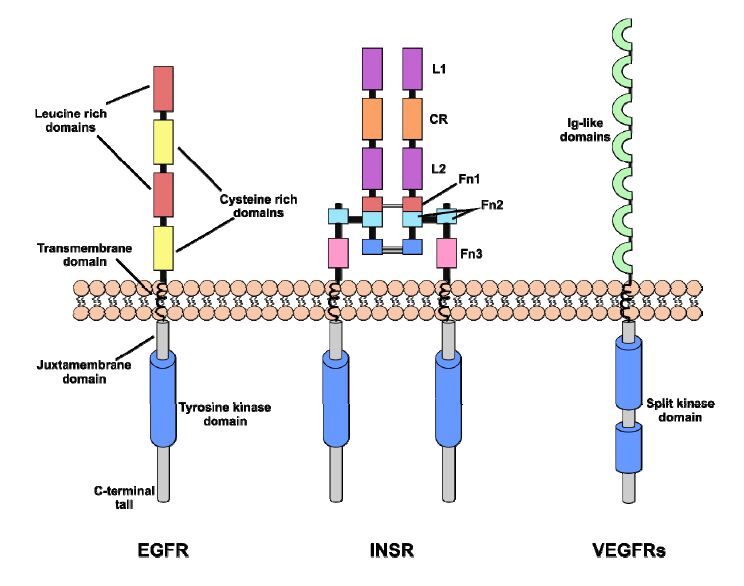
 DownLoad:
DownLoad: 